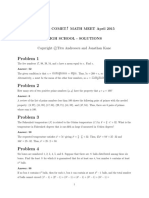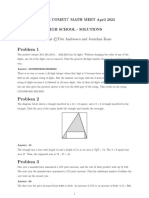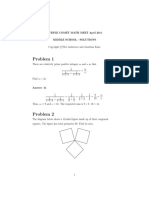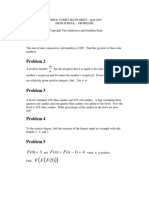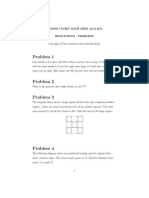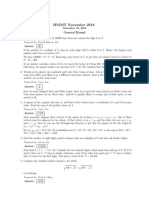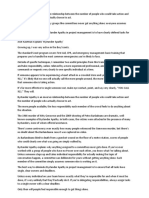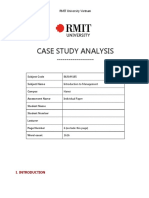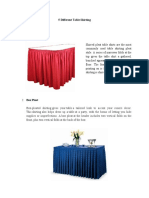2023 MSSolutions
Uploaded by
v kl2023 MSSolutions
Uploaded by
v klApril 2023
Problem 1
Find the sum of the four least positive integers each of whose digits add to 12.
Answer: 210
The four least positive integers whose digits add to 12 are 39, 48, 57, and 66. Their sum is
39 + 48 + 57 + 66 = 210.
Problem 2
There are positive real numbers a, b, c, d, and p such that a is 62.5% of b, b is 64% of c, c is 125% of d, and
d is p% of a. Find p.
Answer: 200
From the given information,
p
a = 0.625b = 0.625 · 0.64c = 0.625 · 0.64 · 1.25d = 0.625 · 0.64 · 1.25 · · a.
100
Therefore, the requested percentage is
100 100 100
p= = 5 = = 200.
0.625 · 0.64 · 1.25 8 · 16
25 ·
5
4
1
2
5
Alternatively, just let c = 1000. Then b = 0.64c = 640 and a = 0.625b = 400. Also, c is 4 of d, so
4
d= 5 · 1000 = 800. Thus, d is 200% of a.
Problem 3
7
Mike has two similar pentagons. The first pentagon has a perimeter of 18 and an area of 8 16 . The second
pentagon has a perimeter of 24. Find the area of the second pentagon.
Answer: 15
The perimeter of the second pentagon is greater than the perimeter of the first pentagon by a factor of
24
18 = 43 . Thus, the area of the second pentagon must be
2
7 4 135 16
8 · = · = 15.
16 3 16 9
1
Problem 4
Positive integer a b c d r s t has digits a, b, c, d, r, s, and t, in that order, and none of the digits is 0. The
two-digit numbers a b , b c , c d , and d r , and the three-digit number r s t are all perfect squares.
Find a b c d r s t .
Answer: 8164961
The two-digit perfect squares are 16, 25, 36, 49, 64, and 81. The only chain of four of these where the last
digit of one is the first digit of the next is 81 → 16 → 64 → 49, so the number a b c d r must be 81649. The
only three-digit square whose first digit is 9 and contains no digit equal to 0 is 312 = 961. Thus, a b c d r s t
= 8164961.
Problem 5
Positive integers m and n satisfy
(m + n)(24mn + 1) = 2023.
Find m + n + 12mn.
Answer: 151
The number 2023 factors as 7 · 172 , so 2023 has divisors 1, 7, 17, 119, 289, and 2023. Because m and n are
positive integers, m + n > 1 and m + n < 24mn + 1. Thus, m + n must be 7 or 17. Letting m = 3 and
n = 4 gives m + n = 7 while 24mn + 1 = 289. So, these values satisfy the needed conditions, and
m + n + 12mn = 3 + 4 + 12 · 3 · 4 = 151. It is not possible that m + n = 17 because then mn ≥ 16, so
24mn + 1 ≥ 385 > 119.
Problem 6
Find the least positive integer such that the product of its digits is 8! = 8 · 7 · 6 · 5 · 4 · 3 · 2 · 1.
Answer: 257889
To write 8! = 27 · 32 · 5 · 7 as a product of digits, two of the digits must be 5 and 7. Because
27 · 32 = 128 · 9 > 9 · 9 · 9, it follows that at least 6 digits are required. The minimal possible digit of the 6
digits would be a 2, and that is possible only if the digits are 2, 8, 8, 9, 5, and 7. Arranging these digits in
increasing order gives 257,889.
Problem 7
Elijah went on a four-mile journey. He walked the first mile at 3 miles per hour and the second mile at 4
miles per hour. Then he ran the third mile at 5 miles per hour and the fourth mile at 6 miles per hour.
m
Elijah’s average speed for this journey in miles per hour was n, where m and n are relatively prime
positive integers. Find m + n.
2
Answer: 99
The total time in hours for Elijah’s journey was
1 1 1 1 19
+ + + = .
3 4 5 6 20
Therefore, Elijah’s average speed in miles per hour was
4 80
19 = .
20
19
The requested sum is 80 + 19 = 99.
Problem 8
Find the number of ways to write 24 as the sum of at least three positive integer multiples of 3. For
example, count 3 + 18 + 3, 18 + 3 + 3, and 3 + 6 + 3 + 9 + 3, but not 18 + 6 or 24.
Answer: 120
The sum 24 = 3 + 3 + 3 + 3 + 3 + 3 + 3 + 3 includes 8 copies of 3 and 7 plus signs. A sum can be created by
performing any of the addition operations. For example, if the middle 5 plus operations are performed, the
result is 3 + 18 + 3. Because there are 7 plus signs, and any subset of these 7 indicated addition operations
can be performed, there are 27 = 128 possible sums of multiples of 3. One of these sums has only one
multiple of 3, 24, and 7 of the sums result in only two multiples of 3. Therefore, the answer is
128 − 1 − 7 = 120.
Problem 9
Find the positive integer n such that
1 + 2 + 3 + · · · + n = (n + 1) + (n + 2) + · · · + (n + 35).
Answer: 84
n(n + 1)
Using the fact that the sum of the first n positive integers is , it follows that
2
n(n + 1) 35 · 36
= 35n + .
2 2
This implies that n2 − 69n − 1260 = 0, which has two solutions, n = −15 and n = 84, so the requested
integer is 84.
3
Problem 10
The figure below shows a smaller square within a larger square. Both squares have integer side lengths.
The region inside the larger square but outside the smaller square has area 52. Find the area of the larger
square.
Answer: 196
Let the larger square have side length a and the smaller square have side length b. Then the region
between the two squares has area 52 = a2 − b2 = (a − b)(a + b). Both a − b and a + b are positive integers
that differ by the even number 2b. The number 52 factors as 52 · 1, 26 · 2, or 13 · 4. The only product where
the factors differ by an even number is 26 · 2, so it must be that a − b = 2 and a + b = 26. Adding these two
equations together gives 2a = 28, implying that a = 14 and b = 12. The requested area of the larger square
is 142 = 196.
Problem 11
Three of the 16 squares from a 4 × 4 grid of squares are selected at random. The probability that at least
m
one corner square of the grid is selected is n, where m and n are relatively prime positive integers.
Find m + n.
Answer: 45
The probability that, out of the possible 16 squares, 3 of the 12 non-corner squares are selected is
12
3 12 · 11 · 10 11
16 = 16 · 15 · 14 = 28 .
3
11 17
Thus, the probability that at least one corner square is selected is 1 − 28 = 28 . The requested sum is
17 + 28 = 45.
4
Problem 12
Find the greatest prime that divides
12 − 22 + 32 − 42 + · · · − 982 + 992 .
Answer: 11
The given alternating sum is equal to
12 + 22 + 32 + · · · + 992 − 2(22 + 42 + 62 + · · · + 982 )
= 12 + 22 + · · · + 992 − 8(12 + 22 + · · · + 492 )
99 · 100 · 199 8(49 · 50 · 99)
= −
6 6
99 · 100
= · (199 − 4 · 49)
6
= 2 · 32 · 52 · 11.
The greatest prime that divides this product is 11.
Alternatively, the sum can be written
992 − 982 + 972 − 962 + 952 − 942 + · · · + 32 − 22 + 12
= (99 + 98)(99 − 98) + (97 + 96)(97 − 96) + (95 + 94)(95 − 94) + · · · + (3 + 2)(3 − 2) + 1
99 · 100
= (99 + 98) + (97 + 96) + (95 + 94) + · · · + (3 + 2) + 1 = = 2 · 32 · 52 · 11.
2
Problem 13
In convex quadrilateral ABCD, ∠BAD = ∠BCD = 90◦ , and BC = CD. Let E be the intersection of
diagonals AC and BD. Given that ∠AED = 123◦ , find the degree measure of ∠ABD.
5
Answer: 78
Because ∠BAD and ∠BCD are supplementary, it follows that quadrilateral ABCD is cyclic. Because
△BCD is isosceles with BC = CD, it follows that ∠BDC = ∠CBD = 45◦ . Because ∠AED is an exterior
angle of △CDE, it follows that ∠EDC + ∠ECD = 123◦ , and, therefore, ∠ECD = 78◦ . Because ABCD is
cyclic, it follows that ∠ABD = ∠ACD = ∠ECD = 78◦ .
E
B D
Problem 14
A square, a regular pentagon, and a regular hexagon are all inscribed in the same circle. The 15 vertices of
these polygons divide the circle into at most 15 arcs. Let M be the degree measure of the longest of these
arcs. Find the minimum possible value for M .
Answer: 48
Because there are 6 vertices of the hexagon and 5 vertices of the pentagon, there must be an arc of the
circle where 2 vertices of the hexagon lie between 2 adjacent vertices of the pentagon. Because there are
72◦ between adjacent vertices of the pentagon and 60◦ between adjacent vertices of the hexagon, one of
these 2 vertices of the hexagon is within 6 degrees of the nearest vertex of the pentagon. Thus, without loss
of generality, there is an x with 0 ≤ x ≤ 6 such that the location in degrees around the circle of the vertices
of the pentagon are 0, 72, 144, 216, and 288, and the vertices of the hexagon are at x, x + 60, x + 120,
x + 180, x + 240, and x + 300. These 11 vertices divide the circle into the following arcs:
Arc 1 2 3 4 5 6 7 8 9 10 11
Start 0 x x + 60 72 x + 120 144 x + 180 216 x + 240 288 x + 300
Measure x 60 12 − x 48 + x 24 − x 36 + x 36 − x 24 + x 48 − x 12 + x 60 − x
6
Notice that arcs numbered 2, 4, and 11 each measure at least 48◦ , and that the arc of the circle made up of
arcs 11, 1, 2, 3, and 4 measures 180◦ . This means that no matter how the square is placed in the circle, at
most two vertices of the square lie within arcs 2, 4, and 11, so no matter how the square is placed in the
circle, the resulting arcs between the vertices of the polygons will have at least one arc which measures at
least 48◦ . On the other hand, letting x = 0 and placing the square so that its vertices are at degree
locations 48, 138, 228, and 318, results in the following arcs:
Arc 1 2 3 4 5 6 7 8 9 10 11 12 13 14
Start 0 48 60 72 120 138 144 180 216 228 240 288 300 318
Measure 48 12 12 48 18 6 36 36 12 12 48 12 18 42
This shows that the three polygons can be placed in the circle so that the measure of the longest arc
created is 48◦ , and, therefore, 48◦ is the requested minimum.
Problem 15
A rectangle with integer side lengths has the property that its area minus 5 times its perimeter equals
2023. Find the minimum possible perimeter of this rectangle.
Answer: 448
Let the rectangle have side lengths m and n. Then the rectangle’s area minus 5 times its perimeter is
mn − 5(2m + 2n) = 2023. Adding 100 to both sides simplifies this to (m − 10)(n − 10) = 2123 = 11 · 193.
The perimeter is minimized when m + n is minimized, and, therefore, when (m − 10) + (n − 10) is
minimized. The sum of the factors m − 10 and n − 10 is minimized when the two factors are as close as
possible. Because 11 and 193 are both prime, the minimum occurs when m − 10 = 11 and n − 10 = 193.
Thus, the minimum perimeter is 2m + 2n = 2(11 + 193 + 2 · 10) = 448.
Problem 16
A sequence of 28 letters consists of 14 of each of the letters A and B arranged in random order. The
m
expected number of times that ABBA appears as four consecutive letters in that sequence is n, where m
and n are relatively prime positive integers. Find m + n.
Answer: 145
There are 25 positions in the sequence of 28 letters where the letters ABBA could appear. In each case,
ABBA appears with probability
14 14 13 13
· · · ,
28 27 26 25
and, thus, the expected number of times ABBA occurs is
14 14 13 13 91
25 · · · · = .
28 27 26 25 54
The requested sum is 91 + 54 = 145.
7
Problem 17
Let x, y, and z be positive integers satisfying the following system of equations:
2023
x2 + = 2y 2
x
2028
y+ 2 = z2
y
2025
2z + 2 = xy
z
Find x + y + z.
Answer: 25
First note that 2023 = 7 · 172 , 2028 = 22 · 3 · 132 , and 2025 = 34 · 52 . Because x and z must be divisors of
2025
2023 and 2025, respectively, they are both odd, and because 2z + 2 is odd, xy and, thus, y must be
z
odd. It follows that y must be 1 or 13. Because y = 1 requires z 2 to be 2029, which is not a perfect square,
2028 2025
it must be that y = 13. Then y + 2 = 13 + 12 = 25 = z 2 , and z = 5. Finally, 2z + 2 = 91 = 13 · 7, so
y z
x = 7. The values x = 7, y = 13, and z = 5 do satisfy the three given equations. Therefore, the requested
sum is 7 + 13 + 5 = 25.
Problem 18
For real number x, let ⌊x⌋ denote the greatest integer less than or equal to x, and let {x} denote the
fractional part of x, that is {x} = x − ⌊x⌋. The sum of the solutions to the equation
2⌊x⌋2 + 3{x}2 = 47 x⌊x⌋ can be written as pq , where p and q are prime numbers. Find 10p + q.
Answer: 232
Let ⌊x⌋ = k and {x} = f , where k is an integer and 0 ≤ f < 1. Then the given equation can be rewritten
as 4(2k 2 + 3f 2 ) = 7(k + f )k, which is equivalent to 0 = k 2 − 7kf + 12f 2 = (k − 3f )(k − 4f ). It therefore
follows that k = 3f or k = 4f . The possible values of (k, f ) are (0, 0), 1, 13 , 2, 23 , 1, 14 , 2, 12 , and
3, 43 . Hence, the solutions to the given equation are 0, 43 , 83 , 54 , 52 , and 15
4 . The sum of these solutions is
23
2 . The requested expression is equal to 10 · 23 + 2 = 232.
Problem 19
A trapezoid has side lengths 24, 25, 26, and 27 in some order. Find its area.
8
Answer: 612
First note that if a trapezoid has parallel sides with lengths M and m with M > m and the other two sides
have lengths a and b with a < b, then segments of length m can be removed from each of the parallel sides,
leaving a triangle with side lengths a, b, and M − m. Thus, these three values must satisfy the triangle
inequality, and, in particular, a + M − m must be greater than b. For this to happen with the four given
side lengths, the value of M − m would have to be either 1, 2, or 3. But if M − m is 1 or 2, it would be
impossible for a + M − m to be greater than b, so it must be that M − m = 3 implying that the parallel
sides of the trapezoid have lengths 24 and 27.
Removing segments of length 24 from the two parallel sides leaves a triangle with side lengths 3, 25, and 26.
That triangle has semiperimeter s = 3+25+26
2 = 27, so the area of the triangle is given by Heron’s Formula
p
as 27(27 − 3)(27 − 25)(27 − 26) = 36. It follows that the height of the triangle to its side with length 3 is
36·2 24+27
3 = 24. Thus, the height of the trapezoid is 24, and its area is 24 · 2 = 612. Note that because
AB + CD = AD + BC, the trapezoid ABCD is circumscribable. It has an inscribed circle of radius 12.
Problem 20
Nine light bulbs are equally spaced around a circle. When the power is turned on, each of the nine light
bulbs turns blue or red, where the color of each bulb is determined randomly and independently of the
colors of the other bulbs. Each time the power is turned on, the probability that the color of each bulb will
m
be the same as at least one of the two adjacent bulbs on the circle is n, where m and n are relatively
prime positive integers. Find m + n.
Answer: 293
Because each bulb has 2 possible colors, there are 29 = 512 equally likely ways for the colors to be chosen.
Suppose the colors are chosen so that each bulb is next to a bulb of the same color. There are 2 ways for
the lights to be all the same color: either all blue or all red. If there are bulbs of both colors and all the
blue bulbs appear next to each other, then there can be either 2, 3, 4, 5, 6, or 7 red bulbs, and they will
also appear next to each other. Thus, there are 6 ways to choose the number of red bulbs and 9 ways to
choose the positions of the red bulbs, so this accounts for 6 · 9 = 54 arrangements. Otherwise, there must
be 4 blocks of bulbs with the same color with 2 bulbs in each block except for one block that contains 3
bulbs. There are 2 ways to choose the color of the lights in the block of 3 bulbs and 9 ways to choose the
position of that block of 3 bulbs, so this accounts for 2 · 9 = 18 arrangements. The required probability is
2 + 54 + 18 37
= .
512 256
The requested sum is 37 + 256 = 293.
You might also like
- Mathematical Náboj 2011-19 EN With Solutions PDF100% (1)Mathematical Náboj 2011-19 EN With Solutions PDF160 pages
- 2011 Math Counts Chapter Competition Solutions100% (1)2011 Math Counts Chapter Competition Solutions11 pages
- ATI TEAS Calculation Workbook: 300 Questions to Prepare for the TEAS (2025 Edition)From EverandATI TEAS Calculation Workbook: 300 Questions to Prepare for the TEAS (2025 Edition)No ratings yet
- Subject: Document PDF / Word Format BilingualNo ratings yetSubject: Document PDF / Word Format Bilingual29 pages
- 1906 Western Tibet and The British Borderland by Charles Sherring SNo ratings yet1906 Western Tibet and The British Borderland by Charles Sherring S397 pages
- Purple Comet MATH MEET April 2019 High School - Problems Titu Andreescu and Jonathan KaneNo ratings yetPurple Comet MATH MEET April 2019 High School - Problems Titu Andreescu and Jonathan Kane6 pages
- 1 Easy Problems: Written Test, 25 Problems / 90 MinutesNo ratings yet1 Easy Problems: Written Test, 25 Problems / 90 Minutes16 pages
- HMMTNovember 2018 General Round SolutionsNo ratings yetHMMTNovember 2018 General Round Solutions4 pages
- High School Math Contest: University of South Carolina February 4th, 2017No ratings yetHigh School Math Contest: University of South Carolina February 4th, 201711 pages
- Trigonometric Ratios to Transformations (Trigonometry) Mathematics E-Book For Public ExamsFrom EverandTrigonometric Ratios to Transformations (Trigonometry) Mathematics E-Book For Public Exams5/5 (1)
- Tolerance in Islam - Muhammad Marmaduke PickthallNo ratings yetTolerance in Islam - Muhammad Marmaduke Pickthall23 pages
- Chapter Four: Managing Marketing Information To Gain Customer InsightsNo ratings yetChapter Four: Managing Marketing Information To Gain Customer Insights36 pages
- Chapter 20 - Central Nervous System DepressantsNo ratings yetChapter 20 - Central Nervous System Depressants24 pages
- PDF Test Bank for Abnormal Psychology 6th Edition NolenHoeksema 0078035384 9780078035388 download100% (24)PDF Test Bank for Abnormal Psychology 6th Edition NolenHoeksema 0078035384 9780078035388 download47 pages
- Case Study Analysis: RMIT University VietnamNo ratings yetCase Study Analysis: RMIT University Vietnam6 pages
- CS3451 - Introduction To Operating Systems: Ii Year / Iv SemesterNo ratings yetCS3451 - Introduction To Operating Systems: Ii Year / Iv Semester21 pages
- Full Download Ocean of Letters Language and Creolization in an Indian Ocean Diaspora Jackman PDF DOCX100% (5)Full Download Ocean of Letters Language and Creolization in an Indian Ocean Diaspora Jackman PDF DOCX71 pages
- Microsoft Surface Pro Charging Port ReplacementNo ratings yetMicrosoft Surface Pro Charging Port Replacement13 pages








